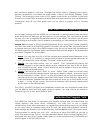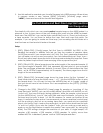
This operator error is due to a misunderstanding of the key range mapping procedure.
When setting key range the A3000 gives you 3 key parameters: Original Key, Low Note,
High Note. If you attempt to place the High note limit lower than the Low note limit, the
A3000 will not let you. Sounds innocent enough? Let’s give an example of how it can bite
you: You originally key mapped a sample as follows:
Original Key = F3, Low = C3, High = C4 .
You attempt to change the samples key range using the Program Easy Edit feature to
the following settings:
Original Key = F1, Low = C1, High = C2.
Basically, moving it down 2 octave from the original key range. This can be done. The
problem arises, in our example, if you attempt to set the High Note limit (to C2)
before
you set the Low Note limit (which is still set to C3). This very thing caused the SOS reviewer,
Chris Carter, to wrongly conclude that you could not set the key range outside of the
original samples key range. But as you can see: you can. Simply set the Low and High
note limits, as necessary, recognizing that the each cannot be outside of the other.
• Sometimes there are dashes under the parameters I want to edit, particularly in [Play]
mode’s Easy Edit and sometimes in [EDIT] mode. I am locked out of editing. Why is
this?
This sounds like you have attempted to edit something while having the software pointing
elsewhere. You are seemingly locked out of Easy Edit mode by the dreaded dashes. This
occurs when in attempting to edit sample you have the software pointing to a Sample
Bank [PLAY]: [SAMPLE]: [SmpBank] instead of at Sample Select - [PLAY]: [SAMPLE]:
[SmpSel]. Or vice versa: you have the software pointing to Sample Select when, in fact,
you want to see the data of a sample that is within a bank. See section on “Editing
samples within a sample bank”.
The screen from which you enter Edit mode makes a difference about what you will see
in the edit buffers. If you enter Easy Edit from the [PLAY]: [SAMPLE]: [SmpBank] screen you
will get the dashes because you are pointing at an individual sample that is part of a
bank – by definition the sample bank allows you to treat all the samples together as if
they were a single sample. Simply, return to the [PLAY]: [SAMPLE]: [SmpSel] screen, point
the software at the entire Sample Bank – it will be listed on the Sample Select list with an
inverse video “B” before its name. Now when you go to Easy Edit you can effect the
entire sample bank (as if it were a single sample) via the parameters.
Conversely, if you attempt to go to the [EDIT] level from the [PLAY]: [SAMPLE]: [SmpSel]
page when attempting to edit a sample that is part of a sample bank, you will get the
dashes. Simply, go back to the [PLAY]: [SAMPLE]: screen and select the [SmpBank] page.
Now when you go back to the EDIT level you will see the data of samples within that
bank.
A3000 Version 2: Enhancements
Yamaha is pleased to announce Version 2 of the A3000 Professional Sampler. Version 2
adds important new performance, editing, and utility features that make the A3000 even
more powerful and even easier to use.


















